
‘Jared, well I have no words to say how much I was impressed by him, by his capability to synthesize, by his aptitude to capitalize everything not only for his own profit.’ — Claire Denis
‘This book is about the destruction of art, both in terms of objects that have been destroyed – lost in fires, floods or vandalism – and the general concept of art operating through object and form. Through re-examinations of such events as the Momart warehouse fire in 2004 and the activities of art thief Stéphane Breitwieser, the book proposes an idea of solvent form hinging on the dual meaning in the words solvent and solvency, whereby art, while attempting to make secure or fixed, simultaneously undoes and destroys through its inception. Ultimately, the book questions what is it that may be perceived in the destruction of art and how we understand it, and further how it might be linked to a more general failure.’ — Manchester University Press
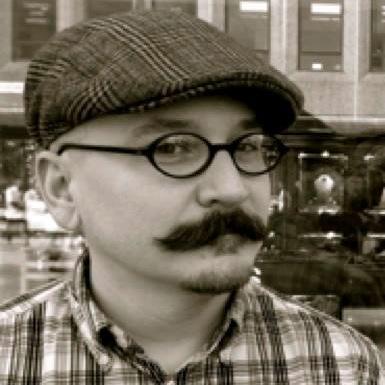
Jared Pappas-Kelley
Things we lost in the fire
Balancing cleverly between states, Jared Pappas-Kelley’s new book Solvent Form considers the destruction of art and our understanding of it, as it slips between various forms both in loss, physically and metaphorically within its own creation. Looking at objects that have been lost through fire or theft, the Momart warehouse fire of 2004 and the wonderful tale of Stéphane Breitwieser’s desire for beautiful artworks, Pappas-Kelley puts forth the concept of solvent with its dual meaning where art has the possibility to undo itself and question how we consider a work that is no longer here.
Jonathan Mayhew: Your new book Solvent Form looks at art and destruction, both as a process and an act that has happened to it. What is it about destruction within the art world intrigues you?
Jared Pappas-Kelley: I actually grew up in places where a lot of these notions of the art world were viewed from afar. I grew up in the States around places like Olympia, Seattle, and Portland, so there was always a sense of making amazing things from nothing or without outside support or from the bones of existing artefacts, creating projects in abandoned buildings and this has probably always informed my approach to art and making. A lot of this was influenced by music and band culture that was around and riot grrrl and DIY and I remember a bit of the culture shock when I was a kid and things like Heavens to Betsy started showing up in magazines like Artforum or people I had gone to school with were suddenly on TV. There was a sort of conceptual collapse for me that simultaneously popped the bubble but also made something new. There was always this sort of pulling one thing apart to create another, and this tension and displacement produced some of the best work, and this sort of vibrant process.
I also remember hearing about one of Robert Irwin’s sculptures getting smashed on accident at an exhibition. Somebody walked out of the toilet or entered the gallery and just knocked it over and there’s something about those moments when things come apart. It is intriguing when theory lends itself to looking at these things and I am also attracted by how those forms of writing almost impersonate the structures or inhabits these ideas, the writing itself is the thing. That’s how a lot of this started.

Sarah Winchester

Winchester Mystery House

Jeremy Blake ‘Winchester’ (frame)
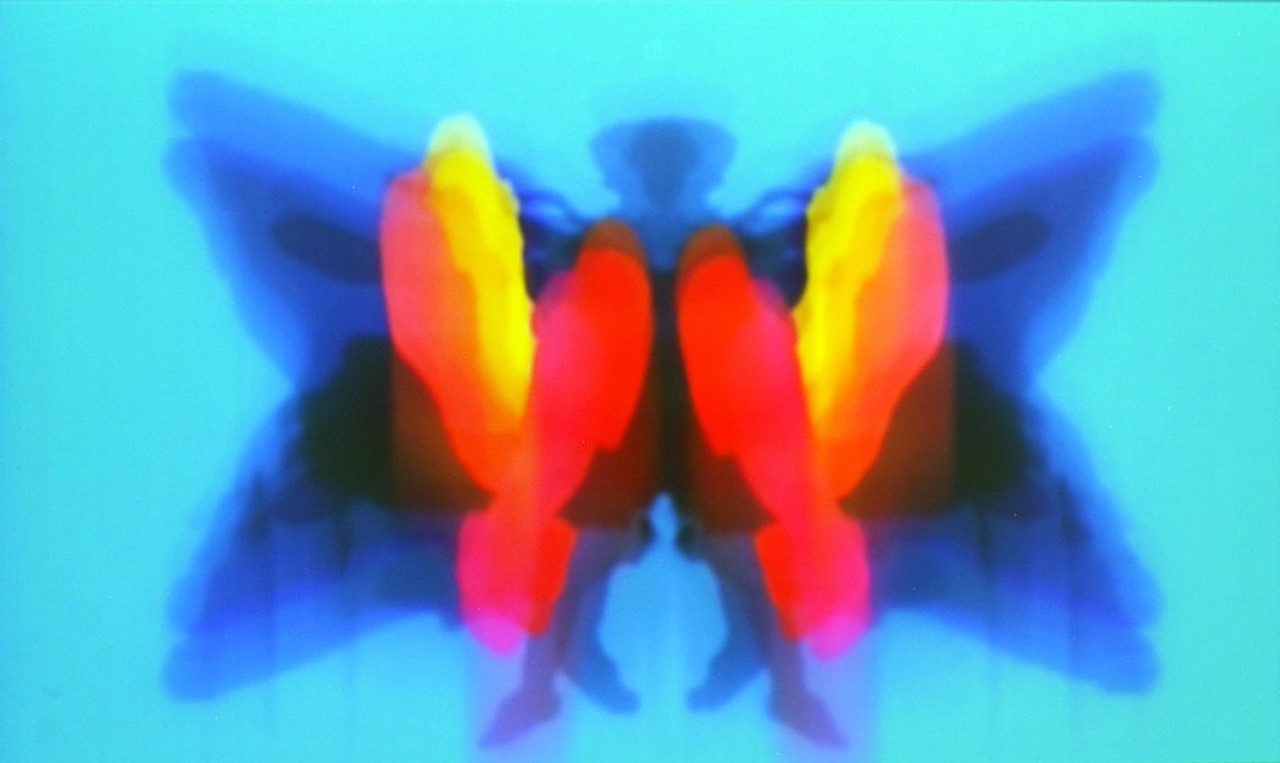
Jeremy Blake ‘Winchester’ (frame)
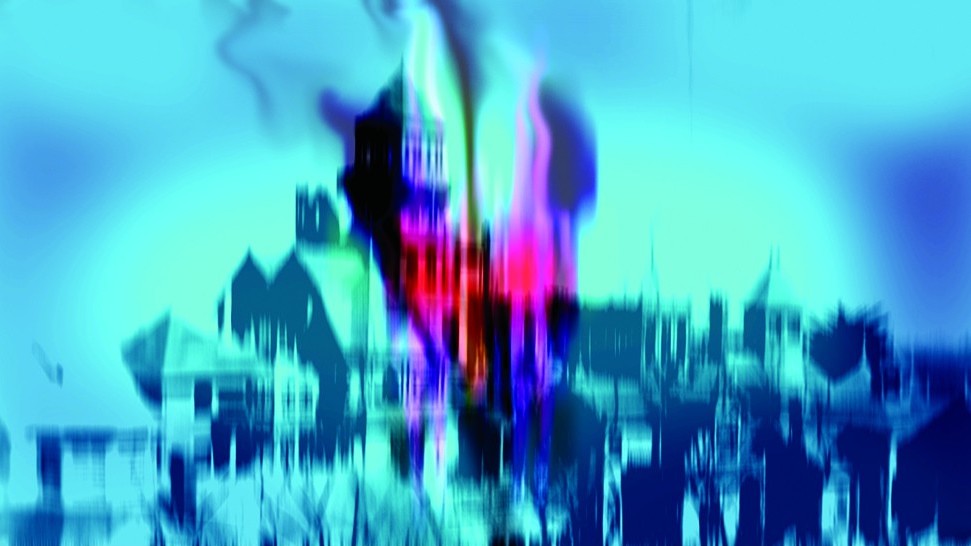
Jeremy Blake ‘Winchester’ (frame)
JM: Rumours, ghosts of lost objects, and ephemeral works and acts haunt your text, but if no one sees a work does it still exist? And what is it about this loss or lack that draws you to these works described in the book?
JPK: In a way art is all a big rumour or ghost story anyway I suppose, even if you just want to think of it in the function of portrait painting. It’s this hope that this object before us will continue even as the person it represents ages or has long since died. That is kind of its fascination, this disappearance that it allows us to see and that is also what draws me to these more ephemeral projects or works that only remain as rumour. You could almost draw a thread to the de-materialization of the object in the 60s, but there is actually this sort of sidestep that takes place with all this work and that is the bit that kept catching my attention. With writing this book, it’s almost like you put all these missing pieces into a room or sitting around some sad little table, with the hope that something other will come to life in the process and show you something more about art.
JM: Yes, I love those works that only exist as stories, those kinds of artworks that have an aura, but aren’t necessarily fixed to an object. Benjamin’s the work of art in the age of mechanical reproduction kept popping up in my head as I was reading your book. In our current age where everything is instagramable and documented, Whiteread’s House is an odd example of a work that still has this presence/aura but I’ve only ever experienced it in reproduction from photographs or video documentation. You talk beautifully about this collapse and do it so the magic of artworks isn’t lost, how do you think her work managed to do this?
JPK: Whiteread’s pieces do a nice job of making something tactile but in almost the blankest manner possible and it allows it to hold all these other things that may or may not be directly related to it. But at the same time it’s almost like this doorstop. Actually in talking about their exact remake of Emin’s tent after the Momart fire, the Chapman Brothers proposed: “It’s not really about Tracey, it is about making something which is so thoroughly recognisable and so fixed and so absent.” In a way, that quote could have just as easily been made about House. There’s also the richness of the story itself with the council wanting to pull it down and then you have all the counterbalance of the previous resident of the house Sid Gale, an elderly dockworker who had spent his life there and his reaction and outrage.

Momart fire
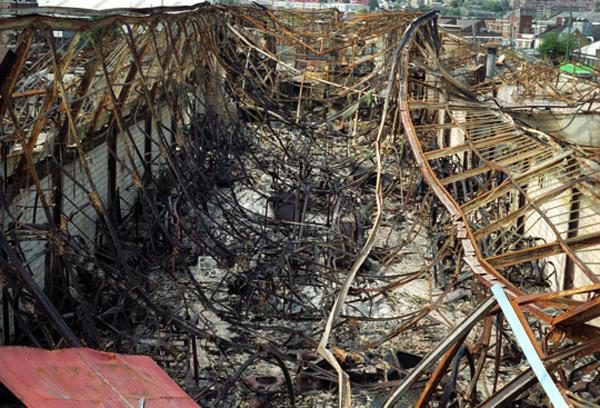
Momart fire

Rachel Whiteread ‘House’
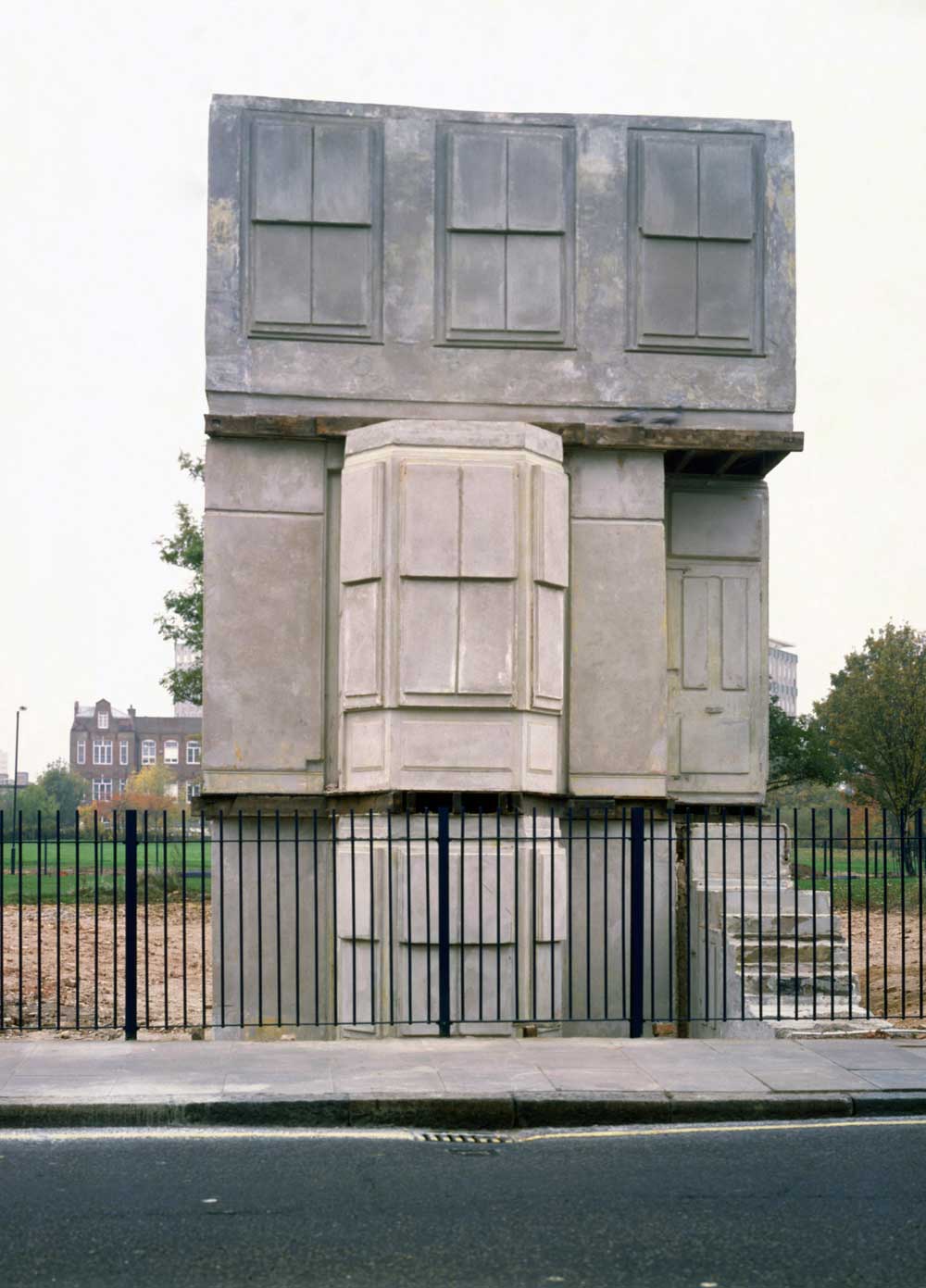
Rachel Whiteread ‘House’
JM: Jonathan Jones’s Museum of Lost Art also haunts the book, Freeport storage units where the uber rich house their collections with showrooms are on the rise, where works exist in these spaces that no one else gets to see like private museums. It also reminded me of the film Children of Men where there is a Ministry of Art, hoarding all these classic works that survived the war, no one else bar the elite get to see these works. What are your thoughts on these lost collections?
JPK: Something has changed about art and we are only now beginning to put our finger on it. Jones and his Museum of Lost Art is a great metaphor for a lot of this and with the rise of these almost off-shore storage compounds—these concentrated absence-zones more like the crypto currency mining farms you always hear about or like the servers for what we think of as cloud computing. They are incredibly resource intensive and influential but designed to be out of sight and disappeared or discretely tucked away to prevent access behind a magic curtain. Most museums can no longer house their own collections on site and a large percentage of their operating costs must go just to paying those storage bills. But with these sites there is almost something Robbe-Grillet with the obsessive accumulation and sprawl that they hoard like a private culture bunker seen through a keyhole. That’s also why things like the Momart fire were so spectacular. One of the funny things about writing about the Momart fire, it’s this crystalline moment with really iconic images in the media of the fire brigades attempting to put out the flames as the Saatchi collection and YBAs went up in blazes and the images are everywhere… but there isn’t a single image of it in my book as the rights were too high. Like the storage spaces, it’s about access, I could write about it, but couldn’t afford to show it with all the other images. Instead I’m working with this textual proxy or stand-in. Actually if it hadn’t been for the Chapman Brothers and their generosity, there wouldn’t have been any images relating to the incident, which seems like this really big hole but also fits with the material itself.
JM: That’s crazy about the images of the fire costing too much to use, but yes their absence really fits in nicely. Museum collections hold these odd hidden histories of works that we never see, all the ins and outs as they move around or things that have happened to them add to their stories, Gardar Eide Einarsson recetly put out a publiction called ‘Conservator’s Notes’ documenting a history of notes about damages to a selection of his works. A fuctioning document that then falls into being an art work in a way. At some point mueuems are going to end up looking like the last scene from Raiders of the Lost Ark where its an endless storage space with copius notes. This is probably why there’s been a massive push to digitise collections so at least a version of a work is viewable, but then we’re back to the problem of how do fully experience a work? Or does that even matter now?
JPK: The Einarsson makes me think of a story my partner has about working in a museum years ago. They had some big Pollock on display and every so often a piece of the paint would just fall off because it was probably all done in housepaint and never really designed to hold up. But it was somebody’s job to come in and collect the little bit of splatter that had fallen off and stick it back on exactly how it had appeared in photographs. In terms of how we experience work, you mentioned instagram before and now people are conditioned to stage their images or even faking it, like pics of drinking mai-tais on a beach somewhere but they are actually sitting in some lonely basement working overtime at a temp job, but in a way that is part of the experience at this point and its complicated.

Gustav Metzger ‘Auto Destructive Art Demonstration’, 1961
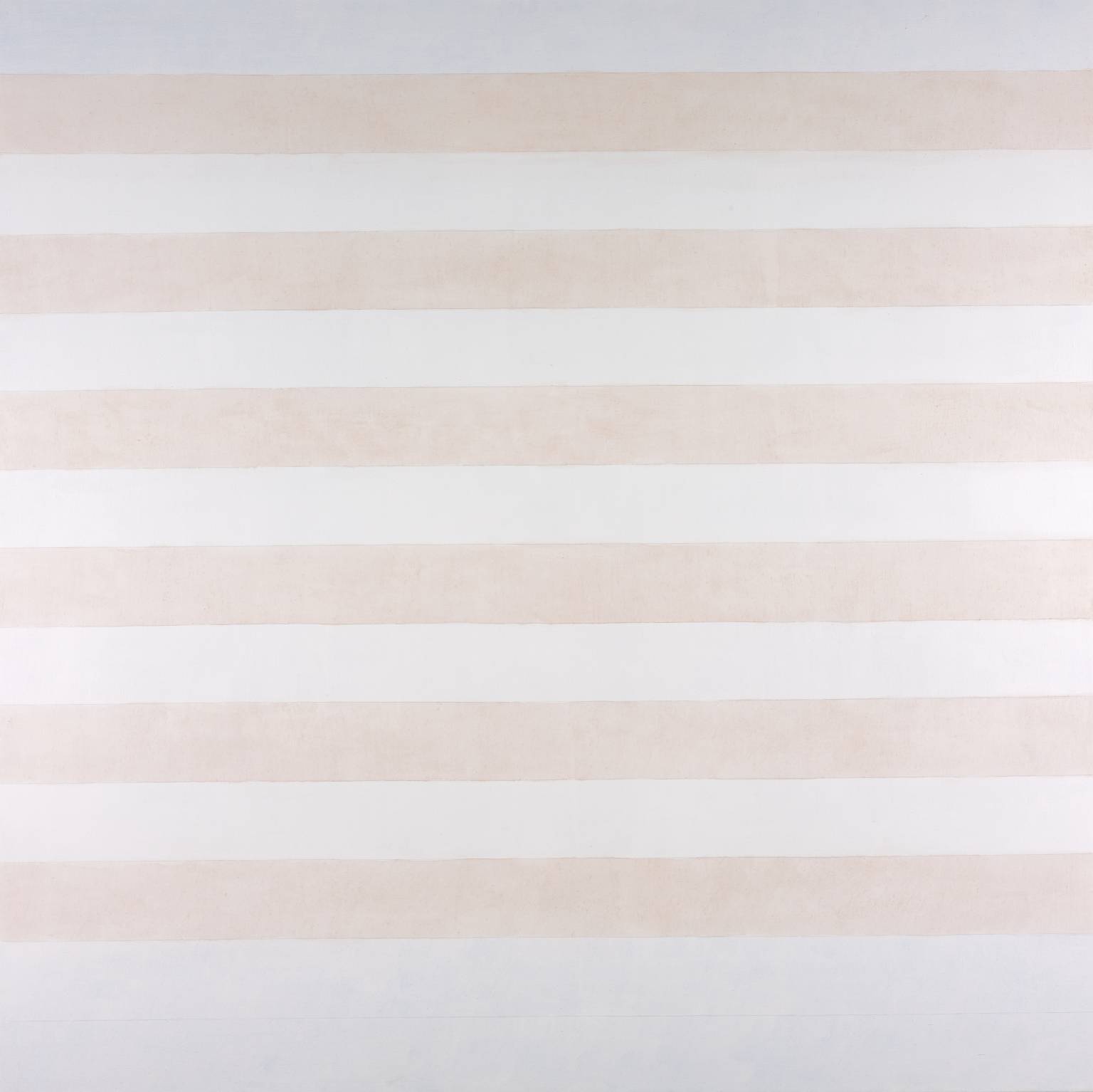
Agnes Martin ‘Happy Holiday’, 1999
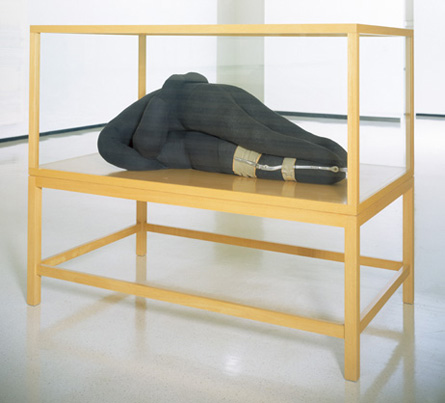
Louise Bourgeois ‘Couple II’
JM: Ok we have to talk about Banksy and his Love is in the Bin shredding stunt, I know you have written about this, but it’s maybe worth exploring a little more. I’m in two minds about the whole thing, as I find there’s a bit of the story that’s off. What’s your take on the whole thing?
JPK: Yes, I was recently asked by my publisher to write a bit about the incident. As far as art destruction I definitely would say it is a rather demure one and it’s pretty impressive and orchestrated how the proceedings went, but since the event more came out about how it actually kind of short circuited and was meant to completely shred the work. It appeals to me more to know that it didn’t go completely to plan and I was trying to think about it in terms of pieces like Jean Tinguely’s Homage to New York, which also went a bit sideways in its undoing. That’s the bit that makes it feel a bit more vital, otherwise it all feels a bit staid like a nativity pageant with the art having a walk-on on stage and proud parents and onlookers in the audience hoping it won’t flub its line. Also there are odd things like how the x-acto blades were attached; they look cool like that but there were much better ways to do that.
JM: I feel Tinguely was more honest in his approach. It was more dealing with speeding up the entropic nature of things rather than an amazing PR stunt. In one way it’s amazing, it’s the closest he can get to returning to how he started out critiquing society, pulling one over on the rich collectors, but he’s also complicit in it. All it’s done is boost the price of his works and the people he was trying to critique haven’t really got it. Also the video of the shedder being installed back in 2006 looks like it was shot pretty recently… But then we’re back to stories and rumours, and well printing the myth is always better than the truth.
JPK: Are artists honest? Tinguely is more about life and the absurdity of how if you try to freeze it in time you kill it, which is also one of those tensions in art in general. The Banksy is more about staging and role rehearsals about art and demonstrating system complacency. It has a playfulness, but in a very rehearsed sense. Someone on my facebook just posted a decorated pie they had made depicting the Banksy shredding, that probably means something? But with all the pre-planning and documentation and supposed backstory of the Banksy piece, it is digestible as an event but also not particularly spontaneous, but it creates an intriguing spectacle. Remember when Michael Jackson awkwardly kissed Lisa Marie Presley at some award show and says something like, ‘and they said our love would never last?’
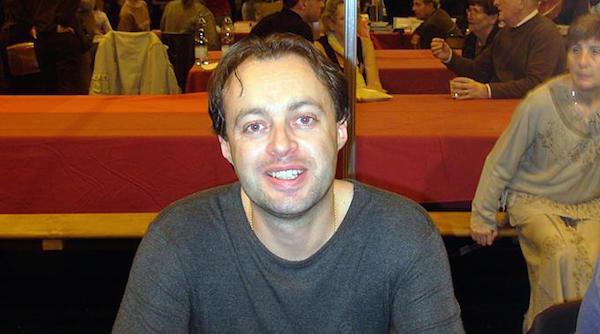
Stéphane Breitwieser, art thief
JM: Fischli and Weiss have said that ‘one of the most beautiful things is that last moment of balance where something is on the verge of collapse.’ We seem obsessed as a culture with collapse, that car crash moment from Kurt Cobain to Lindsay Lohan. Were there any works or areas of culture you wanted to explore that didn’t make it into the book?
JPK: That’s a good quote and I’d actually say that this moment of balance on the verge is the line where art actually resides and that in most instances we are almost always engaging with that line in some capacity. We tend to zoom in or out in the way we think about it in order to not see it, getting caught up in a sense of determinacy, like a coping mechanism. Played in reverse, Lohan firms and becomes a Disney Parent Trap and Cobain is just a nice kid from Aberdeen, their negative miracle. As you can tell, I’m a bit of a tangential writer, but there was a lot of other stuff that almost made it into the book and could become something else in future. One thread was about artists that destroyed all of their earlier work in order to make room for the artist they wanted to become, like Agnes Martin apparently destroyed all of her early stuff as did Louise Bourgeois, and Jenny Holzer’s early work was supposed to be rather painterly.
In Baudrillard there’s also an idea about the revenge of the crystal that was taken from Fatal Strategies where I was thinking of art as its pure object that exerts a sort of violence. There’s a line in ‘The Magic Mountain’: ‘What we call mourning for our dead is perhaps not so much grief at not being able to call them back as it is grief at not being able to want to do so.’ Thomas Hirschhorn included a copy of the Georges Sands novel ‘Laura: A Journey into the Crystal’ in his work the Crystal of Resistance and these ideas around the crystal in this sense influenced a lot of the later writing, but never actually made it into the book.
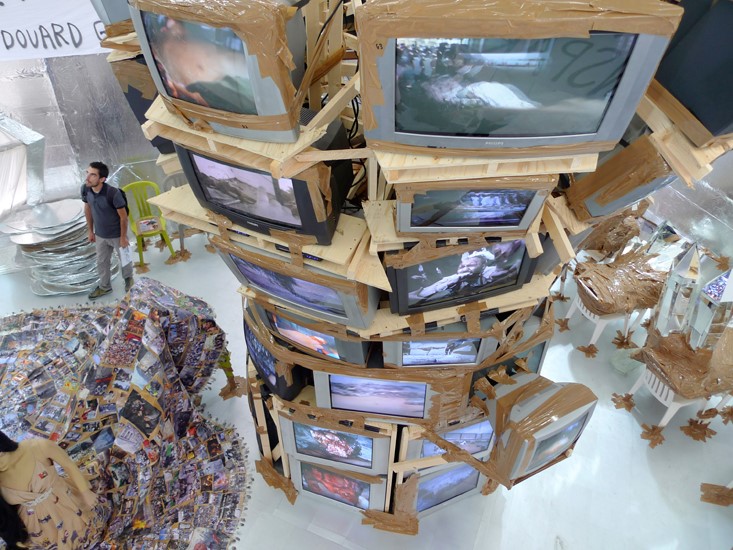
Thomas Hirschhorn ‘Crystal of Resistance’
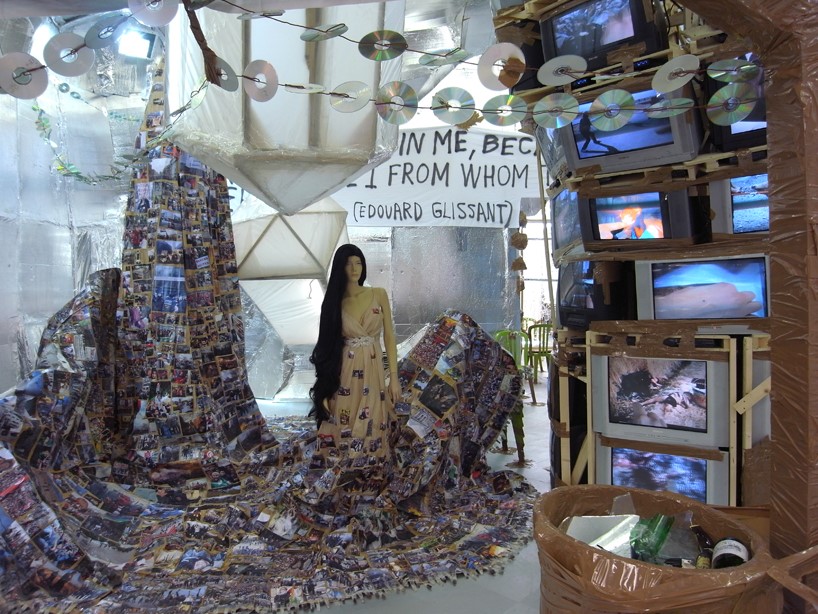
Thomas Hirschhorn ‘Crystal of Resistance’
JM: Crystals are interesting objects, there’s lots of potential in the multiple views and reflections they give, like the endless potential possibilities that exist with current thinking on quantum physics. Could you talk more on the influence of the crystal on your writing?
JPK: In ‘Laura: A Journey into the Crystal’ it talks about vitrification in relation to the crystal which is taking these sort of amorphous aspects and shocking or crystallising them, to turn them into a vitrine (window) in a sense. It is also the lens. In the story, the journey into the crystal represents a sort of feverishness ensnared in the image of order that is fascinating but also a trap. On the other hand, the idea of crystal structures is interesting and how they grow over time and follow a numbering sequence so that something like fluorite has a sequence of four so it is four sided and quartz has six and there is that order and systems as they expand. I wrote something a long time ago called Colour and Chromophobia looking at gems as a metaphor that’s probably floating around somewhere still.
JM: Last two questions. What’s one thing you’re reading, one thing you’re watching, and one thing you’re listening to?
JPK: I was just talking about this, but read too much theory and art related stuff, so I’ve been trying to balance it lately with something more pulpy. Recently, old science fiction and just re-read some old Octavia Butler, which is also kind of sad as some of her dystopian ideas seem to be playing out in current politics. There’s also a copy of the Xenofeminist Manifesto sitting on my desk. Lately I’m watching Man in the High Castle and listening to a lot of synth like NxxxxxS, Jack Chosef, and stuff on A Strangely Isolated Place. How about you?
JM: There’s always too much to read and too little time, but I’ve been rereading for a piece I’m working on, Edouard Levé and Kathy Acker, and re-watching Mr. Robot. Dystopia is the scent of 2018. I’ve been listening to Mica Levi and Eliza McCarthy’s Slow Dark Green Murky Waterfall a lot and as much of Félicia Atkinson’s work as I can get my hands on.
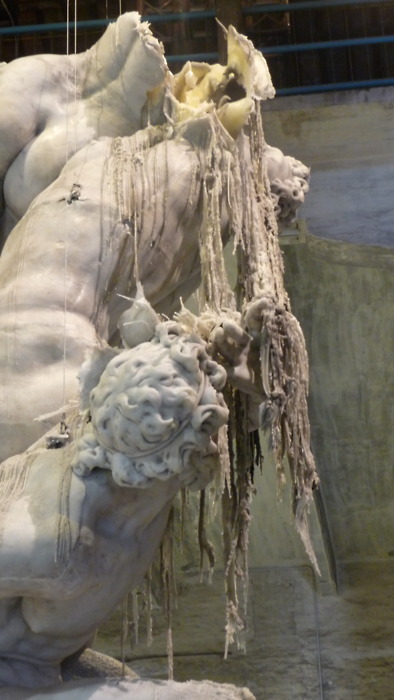
Urs Fischer ‘Untitled’
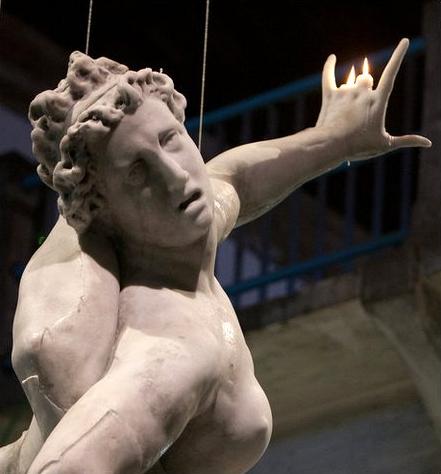
Urs Fischer ‘Untitled’
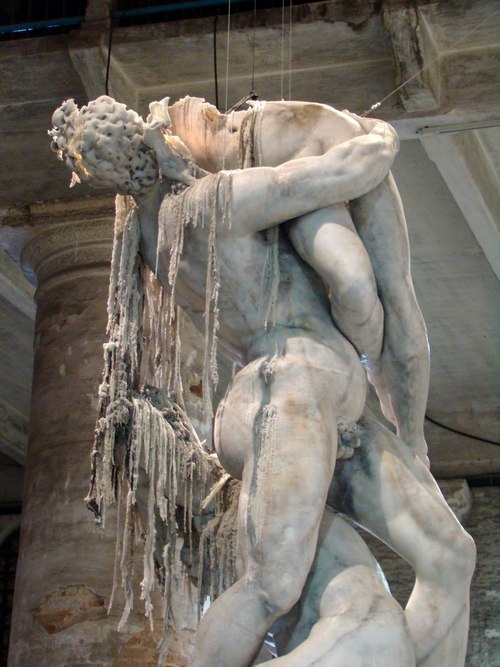
Urs Fischer ‘Untitled’
JM: And finally I think we need to start a rumour, so what’s next?
JPK: Sounds good, what do you have in mind? Any suggestions? I’ve been working on a collection of new manifestos by people like Santiago Sierra, Thomas Hirschhorn, Rebecca Brown, Jean-Luc Nancy, Simon Critchley, Geert Lovink, Lev Manovich, and a bunch of others but has been on the backburner for a long time while I finished this book. I also have a project where I have been writing short insight readings of specific contemporary works of art that will form a collection almost like an oracle of these tight little vignettes. I also have a series of video/audio pieces I’ve worked on from cut-up bonsai tree tutorials from youtube with the working title of Sandai-Shogun-No Matsu: the bonsai modes. I have a fantasy of releasing the audio on vinyl as a record.
JM: Putting out something on vinyl is top of my list too. I have a few pieces I’m planning to make once a new bit of equipment shows up. Maybe we should say there’s a split double A side coming out? (Insert winky emoji) Your manifestos book sounds great! I hope we won’t have to wait too long before it comes out. I should start a rumour that I’m making a book, just so it will force me to make a book. Right, I better let you go to that fancy dinner at the Tate and I’ve got to get ready for a studio visit with you know HUO. This has been very enjoyable. Oh and a quick question to end, how would you sum up your book in one sentence?
JPK: Er, Solvent Form is a book for understanding art differently through art’s destruction as well as stories like Scheherazade from One Thousand and One Nights or the Sarah Winchester story. There’s a line in the book: ‘Beginning here it is hoped that through a similar strategy an understanding of the destruction of art might emerge, and that these investigations might likewise appear, little by little, as a series of bombs in the shape of a book for understanding something of destruction in art.’ How’s that?
JM: Perfect!
Jonathan Mayhew is an artist and occasional writer, he has recently shown at IMMA, the Irish Museum of Modern Art, The Butler Gallery, Ireland and Kristiansand Kunsthall in Norway, he is currently based between Ireland and Sweden.
Extracurricular: Videos by Jared Pappas-Kelley
Wandering the Garden
Desperately Seeking Louden
Some Say She Lost Her Head
The Thing that is not a Thing (rough cut)
The Quiet Life (rough cut)
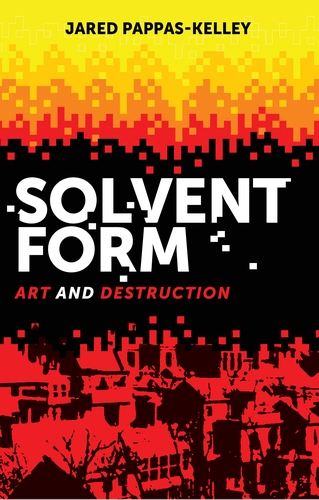
Jared Pappas-Kelley Site
Jared Pappas-Kelley @ Twitter
Jared Pappas-Kelley @ Vimeo
*
p.s. Hey. Today the blog has the honor and pleasure of helping usher a fantastic book into the world, i.e. Jared Pappas-Kelley’s ‘Solvent Form’, which you eagle-eyed people will recognise from its very deserved spot in my list of favorite non-fiction books of this year. Jared’s not only a writer/thinker of huge note, he’s also a sterling artist as well as a longtime member of the blog’s commenter gang. But enough hype. Please check out the post’s evidence of his book, consider its acquisition, and leave your comments in the usual arena. Thank you very much, and thank you, Jared, for letting this place participate in the birth. ** David Ehrenstein, Hi. Well, I’m nothing but very happy that Rechy was so helpful to you. ** Sypha, I thought I had remembered you being a Laffoley fan, so cool. ** Steve Erickson, Hi. Everyone, Mr. Erickson has written a remembrance of the newly late, very great songsmith, star, and Buzzcocks mastermind Pete Shelley. Please pay your respects here. Yeah, even here, the Audiard film came and went very quickly. Shame because, as someone else mentioned, it’s based on the fantastic novel by the wonderful writer and one-time regular commenter here Patrick DeWitt. I didn’t see the film, heard very mixed things. Yeah, ‘The Sluts’s’ success was a really big surprise. My agent of the time didn’t like it and told me to put it in a drawer and not publish it. But then that ltd. ed. press asked me for something, and I gave them novel thinking ‘why not’ since it was just a ltd. ed. thing, and then … it just took off. You never know. I would imagine ‘PGL’ might get some of that in States since it’s gotten that elsewhere — not in the press and reviews so much, but some festival curators who’ve rejected it said they mostly did so because it’s not LGBT enough, which is obviously weird since the film was never intended to be an LGBT film and the festivals weren’t LGBT-directed festivals. That just seems bizarre and stupid to me, but whatever. Oh, your film is live! Everyone, … and Mr. Erickson’s new short (9m minute) film, ‘Culture Shock’, is now available for every single one of us to view, so join me in discovering and feasting on it. It’s here. ** H, Hi! Thank you. All is well here, just bee-style busy as mostly usual. We decided on one of the buches — this one — for a feast on this coming Monday, and the other one or two will be decided by this weekend. Have lovely holidays! ** StKeatonlas, Festive! With an edge! Meth just did the usual hollowing out thing it does to everyone to me during my stint funning-out with it, so my brief longings are mostly bad habit retracings or something. Cool you got into Laffoley. Stay perked. ** Misanthrope, Hi. Yeah, I’ve reached the outer limit of my ability to discuss The Doors without getting critical, so let’s smile and wag our heads at each other. Ready? *Go* Ah, nice. I like bland cookies. They’re my faves. I don’t even think they’re bland. I think they’re deliciously understated. There are many people who think any writing about sex or violence or etc. that is at all explicit is automatically gratuitous. See what your new friend thinks, but don’t be surprised, especially if his recommendation is Maupin. Enjoy NYC! I’m sure you will! I think the Warhol retro is at the Whitney. Have biggest fun! ** Nik, Hi. Yeah, I think when you start to get into sentences, that’s when writing starts to get excitingly scientific and druggy in the good way. I’m a total sentence fetishist. It’s almost what makes or breaks fiction for me. When I read a writer who has sentence-making genius, from Gary Lutz to Foster-Wallace to Joy Williams to … , I go crazy with excitement trying to figure out how they did that. Okay, understood about why the confusion might have arisen. Makes sense, thank you for sharing that. Enjoy sorting that out. Very happily, Gisele really liked Episode 1 and only had the most minimal requests, so it’s maybe an hour from being finished now. ‘News From Home’ is so, so great, right? Akerman is amazing, yeah. She’s very, very high on Zac’s favorite/most influential directors list. Thanks for the luck, and plenty of mine for yours is winging your way as you read. ** Right. Please give Mr. Pappas-Kelley’s fascinating book your all today, thank you. See you tomorrow.




 Now available in North America
Now available in North America 
Pappas-Kelley is indeed fascinating. Jean Tinguely is referenced in both “Good Neighbor Sam” and “Mickey One” — tow films that couldn’t be more different.
IT’S JANE BIRKIN’S BIRTHDAY !
Dump Macron. Replace him with Jane. Problem solved.
Hi!!
Hey, Dennis, how are you? How’s your back? If I’m correct, the deadline for the TV script is pretty close now so you’re almost free, right? How’s it going?
Only five more days for me as a full-time employee! Five, starting on Monday.
My week was pretty uneventful. I almost can’t believe it but the coughing shit I had only like two weeks ago is back. Other than this, there was this “company dinner” I was invited to yesterday (apparently the company that runs the shop does this every year). Everyone looked really fancy and I was there in a simple striped sweater and my Martens boots, feeling supremely awkward. I’ve never been to anything like this before, all those “very important” people laughing politely at each others’ completely flat jokes, Jesus. It was ludicrous, haha.
I do hope the highlight of your week was… well, at least a bit more enjoyable.
Have an amazing weekend!!
Thanks Dennis, this is really lovely and much appreciated!
Hi D
It was fun to interview Jared 🙂 and it was a breeze as the book is wonderful!
And the extra bonus works are great to see again.
Hope all is nice in Paris and that you were out of the way for the protests. My mind is still trying to take in all the Buche’s, this year was outstanding. Which ones did you choose?
Ive been a bit all over the place for the last few weeks, but I’m in Dublin for a minute before heading up to the lands of black metal for Jul.
Oh the new KTL album is awesome! I also picked up the The Ventriloquist Convention Demos, which I love too.
Ok gotta crash work in the morning…
jx
I remember the Saatchi warehouse fire a few years ago when all that art was destroyed, and the British general public just thought it was hilarious. We’re all philistines over here and the world is quite right to laugh at us.
I was at the DCA’s Visual Research Centre this evening for the Dundee Print Collective’s show Postcard To Europe that was a kind of exchange with a group of printers in Barcelona. My Separatist Propaganda World Cup Wallchart print was on show and it got a couple of sales which is good to know. Anyway at the weekend I’ll be in the print workshop and my plan is to finally produce the long awaited Diamond Dust Camperdown Elms artwork.
This interview seems quite thorough and makes Pappas-Kelly sound like a very interesting theorist. I wonder if McNally Jackson carries this book.
Here’s a link to my 2018 music top 10 list in Gay City News: https://www.gaycitynews.nyc/stories/2018/26/bestmusic-music-2018-12-20-gcn.html?fbclid=IwAR17qkP9oBjJTMPoZrRvI9IxbLgGTfUoFvNTNTwqw-fpxlCgQzsFL1sE7sU
I hate how LGBTQ identity can turn into a pigeonhole/niche that winds up telling artists “this is your place,” no matter what they actually make or how they think about their sexuality and the role it plays it their work.
I got Esoteric/Cherry Red’s recent and extensive Third Ear Band compilation ELEMENTS 1970-1971. They seem to be remembered these days only for their soundtrack to Polanski’s MACBETH, but they had an occult/medieval vibe akin to Comus without any vocals or such direct references to Britain’s folk tradition, although there are occasional moments with a “Renaissance Faire” ambience. I could see them getting hired to score THE WICKER MAN if they were still together at that point. ELEMENTS 1970-1971 brings together their self-titled album, their excellent soundtrack to the 1970 German film ABELARD AND HELOISE, 2 Peel sessions and unreleased demos.